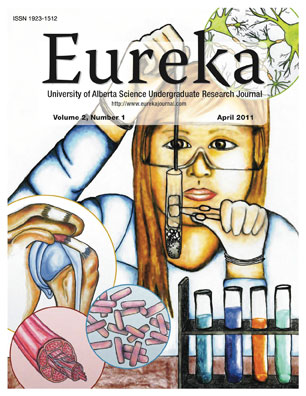Sterol Chemical Structure and Conformation Influence the Thermotropic Phase Behaviour of Dipalmitoylphosphatidylcholine Bilayers
DOI:
https://doi.org/10.29173/eureka10294Abstract
Studying the nature of interactions between the sterol ring system and neigbouring phospholipid molecules is important for our understanding of the properties of sterols in biological molecules and the role of such interactions in many disease processes. In this project, the thermotropic phase behaviour of binary dipalmitoylphosphatidylcholine (DPPC)/sterol mixtures with different sterol ring configurations (C5,6 double bond, 5α-H and 5β-H orientation and either 3α-OH, 3β-OH, 3-ketone functional groups) was investigated using differential scanning calorimetry (DSC) and was compared to earlier studies of cholesterol/ and epicholesterol/DPPC mixtures. Given the differences in the thermodynamic parameters obtained from these mixtures and their associated changes in bilayer stability and miscibility, it is clear that changing the sterol chemical configuration has a significant effect on bilayer properties. Any sterol molecule whose ring structure deviates from that of cholesterol is unlikely to be fully miscible in mammalian membranes.
Downloads
Downloads
Published
How to Cite
Issue
Section
License
By signing the Eureka publication agreement, authors agree to the following:
- The work has not been previously published in any format;
- Eureka is granted the royalty-free right to publish and disseminate the work in current and future formats;
- The work will be published in Eureka under a Creative Commons license. Eureka encourages authors to publish the work under a Creative Commons Attribution 4.0 International license (CC BY 4.0) that allows others to distribute, tweak, and build upon the work, even commercially, as long as they credit the Author(s) for the original creation.
Authors may however choose to have their work distributed under any of the Creative Commons licenses currently available by specifying their preferred license in the publication agreement. A description of the Creative Commons licenses is available here: https://creativecommons.org/licenses/
- Authors retain their copyright, including the right to subsequently publish or disseminate their work elsewhere, provided that they make reasonable efforts to ensure that the publication in Eureka is acknowledged.
- Authors agree to determine, prior to publication, whether it is necessary to obtain permissions from any third party who hold rights with respect to any photographs, illustrations, drawings, text, or any other material (“third party work”) to be published in connection with your work. Copyright permission will not be necessary if the use is determined to be fair dealing, if the work is in the public domain, or if the rights-holder has granted a Creative Commons or similar license.
- All co-authors and investigators (e.g. faculty supervisors) with claims to the intellectual property have read and signed the agreement, thereby providing their consent for the submission to be published in Eureka.
Unless otherwise specified, authors guarantee that all parts of the submission are the author’s original work. Submissions containing evidence of plagiarism will not be eligible for publication.



